
The Last Supper is the final meal that, in the Gospel accounts, Jesus shared with his apostles in Jerusalem before his crucifixion. The Last Supper is commemorated by Christians especially on Maundy Thursday. The Last Supper provides the scriptural basis for the Eucharist, also known as "Holy Communion" or "The Lord's Supper".

The Last Supper is a mural painting by the Italian High Renaissance Leonardo da Vinci, dated to c. 1495–1498. The painting represents the scene of the Last Supper of Jesus with the Twelve Apostles, as it is told in the Gospel of John – specifically the moment after Jesus announces that one of his apostles will betray him. Its handling of space, mastery of perspective, treatment of motion and complex display of human emotion has made it one of the Western world's most recognizable paintings and among Leonardo's most celebrated works. Some commentators consider it pivotal in inaugurating the transition into what is now termed the High Renaissance.

Paolo Caliari, known as Paolo Veronese, was an Italian Renaissance painter based in Venice, known for extremely large history paintings of religion and mythology, such as The Wedding at Cana (1563) and The Feast in the House of Levi (1573). Included with Titian, a generation older, and Tintoretto, a decade senior, Veronese is one of the "great trio that dominated Venetian painting of the cinquecento" and the Late Renaissance in the 16th century. Known as a supreme colorist, and after an early period with Mannerism, Paolo Veronese developed a naturalist style of painting, influenced by Titian.
The Last Supper refers to the last meal that Jesus Christ took with his disciples.

The Potato Eaters is an oil painting by Dutch artist Vincent van Gogh painted in April 1885 in Nuenen, Netherlands. It is in the Van Gogh Museum in Amsterdam. The original oil sketch of the painting is at the Kröller-Müller Museum in Otterlo, and he also made lithographs of the image, which are held in collections including the Museum of Modern Art in New York City. The painting is considered to be one of Van Gogh's masterpieces.
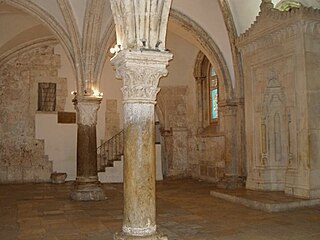
The Cenacle, also known as the Upper Room, is a room in Mount Zion in Jerusalem, just outside the Old City walls, traditionally held to be the site of the Last Supper, the final meal that, in the Gospel accounts, Jesus held with the apostles.
Nineteen Day Feasts are regular community gatherings, occurring on the first day of each month of the Baháʼí calendar. Each gathering consists of a Devotional, Administrative, and Social part. The devotional part of the Nineteen Day Feast can be compared to Sunday Services in Christianity, Friday Prayers in Islam, or Saturday Prayers in Judaism; however, the Baháʼí Faith has no clergy nor is congregational prayer performed at these meetings.

Dieric Bouts was an Early Netherlandish painter.

The Upper Room is a Christian organization that publishes books and magazines and that produces programs to support the spiritual life of Christians around the world. The Upper Room is best known for The Upper Room daily devotional, which is published in 35 languages and is available in more than 100 countries. Other publications include devozine for teens and Pockets for children. Programs include The Walk to Emmaus and The Academy for Spiritual Formation.
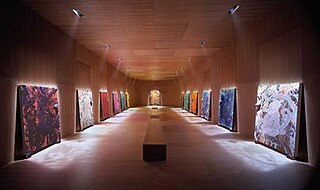
The Upper Room is an installation of 13 paintings of rhesus macaque monkeys by English artist Chris Ofili in a specially-designed room. It was bought by the Tate gallery in 2005 from the Victoria Miro Gallery and was the cause of a media furore after a campaign initiated by the Stuckist art group as Ofili was on the board of Tate trustees at the time of the purchase. In 2006 the Charity Commission censured the Tate for the purchase, but did not revoke it.
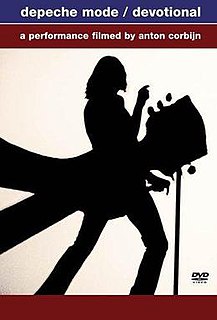
Devotional – A Performance Filmed by Anton Corbijn is a video release by Depeche Mode, featuring almost an entire concert from their 1993 Devotional Tour, filmed in Barcelona, Spain, Liévin, France and Frankfurt, Germany (Festhalle). It was directed by Anton Corbijn, and released in 1993. It was nominated for the Grammy Award for Best Long Form Music Video in 1995. The soundtrack was recorded in Liévin, Stade Couvert Régional, on 29 July 1993.
P.S. I Love You may refer to:
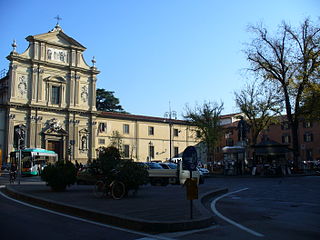
Museo Nazionale di San Marco is an art museum housed in the monumental section of the medieval Dominican friary dedicated to St Mark, situated on the present-day Piazza San Marco, in Florence, a region of Tuscany, Italy.

Sister Plautilla Nelli (1524–1588) was a self-taught nun-artist and the first known female Renaissance painter of Florence. She was a nun of the Dominican convent of St. Catherine of Siena located in Piazza San Marco, Florence, and was heavily influenced by the teachings of Savonarola and by the artwork of Fra Bartolomeo.

The Sacrament of the Last Supper is a painting by Salvador Dalí. Completed in 1955, after nine months of work, it remains one of his most popular compositions. Since its arrival at the National Gallery of Art in Washington, D.C. in 1955, it replaced Renoir's A Girl with a Watering Can as the most popular piece in the museum.

The Last Supper of Jesus and the Twelve Apostles has been a popular subject in Christian art, often as part of a cycle showing the Life of Christ. Depictions of the Last Supper in Christian art date back to early Christianity and can be seen in the Catacombs of Rome.

The Last Supper (1630–1631) is an oil painting by Peter Paul Rubens. It was commissioned by Catherine Lescuyer as a commemorative piece for her father. Rubens created it as part of an altarpiece in the Church of St. Rombout (Rumbold) in Mechelen. The painting depicts Jesus and the Apostles during the Last Supper, with Judas dressed in blue turning back towards the viewer and away from the table. Other than Jesus, the most prominent figure is Judas. Judas holds his right hand to his mouth with his eyes avoiding direct contact with the other figures in the painting creating a nervous expression. Jesus is dressed in red and has a yellow halo surrounding his head with his face tilted upwards. Jesus is located centrally in the painting surrounded by his disciples with six on each side, and he holds a loaf of bread with a cup of wine in front of him. Out of all of the figures, he is the most in the light with the figures to the farthest left being the most in shadow. “The scene thus represents a perfect conflation of the theological significance of the Last Supper” meaning the conflation between the blessing of the bread and the wine while still being pivotal in the sense of revealing the betrayal.

The conservation-restoration of Leonardo da Vinci's The Last Supper is an ongoing project that has spanned many centuries. Completed in the late 15th century by the Renaissance artist Leonardo da Vinci, the mural is located in the refectory of the Convent of Santa Maria delle Grazie, Milan, Italy. The Last Supper was commissioned by Ludovico Sforza, Duke of Milan in 1495, as part of a series of renovations to the convent with the intention that the location would become the Sforza family mausoleum. Work began on The Last Supper in 1495 and lasted until 1498. The scene is understood to depict the Bible verse John 13:22, showing the reactions of the Twelve Disciples, at the Last Supper, in the moments following Jesus’s announcement that one among them will betray him.
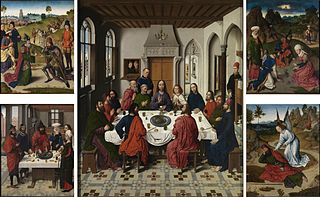
Altarpiece of the Holy Sacrament or Triptych of the Last Supper is a 1464–1468 dated triptych attributed to Dieric Bouts, now reassembled and held at its location of origin at St. Peter's Church, Leuven.

Lutheran art consists of all religious art produced for Lutherans and the Lutheran Churches. This includes sculpture, painting, and architecture. Artwork in the Lutheran Churches arose as a distinct marker of the faith during the Reformation era and attempted to illustrate, supplement and portray in tangible form the teachings of Lutheran theology.















